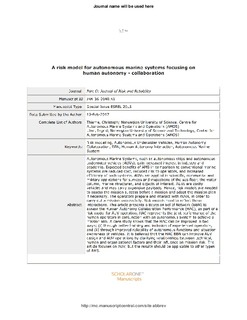| dc.contributor.author | Thieme, Christoph Alexander | |
| dc.contributor.author | Utne, Ingrid Bouwer | |
| dc.date.accessioned | 2017-08-08T08:09:10Z | |
| dc.date.available | 2017-08-08T08:09:10Z | |
| dc.date.created | 2017-08-07T10:03:31Z | |
| dc.date.issued | 2017 | |
| dc.identifier.citation | Proceedings of the Institution of Mechanical Engineers. Part O, Journal of risk and reliability. 2017, 231 (4), 446-464. | nb_NO |
| dc.identifier.issn | 1748-006X | |
| dc.identifier.uri | http://hdl.handle.net/11250/2450091 | |
| dc.description.abstract | Autonomous marine systems, such as autonomous ships and autonomous underwater vehicles, gain increased interest in industry and academia. Expected benefits of autonomous marine system in comparison to conventional marine systems are reduced cost, reduced risk to operators, and increased efficiency of such systems. Autonomous underwater vehicles are applied in scientific, commercial, and military applications for surveys and inspections of the sea floor, the water column, marine structures, and objects of interest. Autonomous underwater vehicles are costly vehicles and may carry expensive payloads. Hence, risk models are needed to assess the mission success before a mission and adapt the mission plan if necessary. The operators prepare and interact with autonomous underwater vehicles to carry out a mission successfully. Risk models need to reflect these interactions. This article presents a Bayesian belief network to assess the human–autonomy collaboration performance, as part of a risk model for autonomous underwater vehicle operation. Human–autonomy collaboration represents the joint performance of the human operators in conjunction with an autonomous system to achieve a mission aim. A case study shows that the human–autonomy collaboration can be improved in two ways: (1) through better training and inclusion of experienced operators and (2) through improved reliability of autonomous functions and situation awareness of vehicles. It is believed that the human–autonomy collaboration Bayesian belief network can improve autonomous underwater vehicle design and autonomous underwater vehicle operations by clarifying relationships between technical, human, and organizational factors and their influence on mission risk. The article focuses on autonomous underwater vehicle, but the results should be applicable to other types of autonomous marine systems. | nb_NO |
| dc.language.iso | eng | nb_NO |
| dc.publisher | SAGE | nb_NO |
| dc.relation.uri | http://journals.sagepub.com/doi/full/10.1177/1748006X17709377 | |
| dc.title | A risk model for autonomous marine systems and operation focusing on human–autonomy collaboration | nb_NO |
| dc.type | Journal article | nb_NO |
| dc.type | Peer reviewed | nb_NO |
| dc.description.version | submittedVersion | nb_NO |
| dc.source.pagenumber | 446-464 | nb_NO |
| dc.source.volume | 231 | nb_NO |
| dc.source.journal | Proceedings of the Institution of Mechanical Engineers. Part O, Journal of risk and reliability | nb_NO |
| dc.source.issue | 4 | nb_NO |
| dc.identifier.doi | 10.1177/1748006x17709377 | |
| dc.identifier.cristin | 1484448 | |
| dc.relation.project | Norges forskningsråd: 223254 | nb_NO |
| dc.description.localcode | This is the authors' manuscript to the article (preprint). | nb_NO |
| cristin.unitcode | 194,64,20,0 | |
| cristin.unitname | Institutt for marin teknikk | |
| cristin.ispublished | true | |
| cristin.fulltext | preprint | |
| cristin.qualitycode | 1 | |
